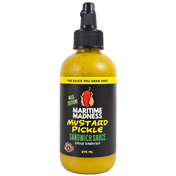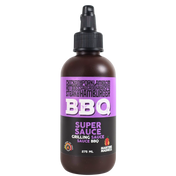Have you ever wondered what makes hot sauce so irresistibly spicy? It's not just the fiery flavour that tickles our taste buds; it's the fascinating world of hot sauce chemistry! Join us on a scientific adventure as we unravel the secrets behind the heat, flavour, and sensory experience of hot sauce. Get ready to dive into the captivating world of capsaicin, chemical compounds, and flavour profiles that make Maritime Madness Hot Sauce awesome!
- The Fiery Heat: Unleashing the Power of Capsaicin
When you take a bite of a spicy pepper and feel that fiery sensation we all know and love, it's all thanks to capsaicin - the superstar spicy food compound!
The science behind capsaicin and its fiery effects is truly fascinating. When we consume foods containing capsaicin - such as hot sauce - it interacts with a receptor in our taste buds called the transient receptor potential vanilloid 1 (TRPV1) receptor. This receptor is responsible for detecting heat and pain.
When capsaicin comes into contact with the TRPV1 receptor, it binds to it and triggers a series of chemical signals that fool our brain into thinking we're experiencing heat. This leads to the familiar burning sensation we associate with spicy foods.
In response to the activation of the TRPV1 receptor, our brain releases endorphins, which are natural pain-relieving and mood-enhancing compounds. This is why some people experience a sense of pleasure and euphoria when consuming spicy foods.
Over time, regular consumption of capsaicin can actually increase our tolerance to spicy foods. This is because repeated exposure to capsaicin desensitizes the TRPV1 receptors, making them less responsive to subsequent exposures.
So, the next time you savour the heat of hot sauce, remember that it's the result of a fascinating interplay between capsaicin, our taste buds, and our brain's perception of heat and pain!
2. Flavourful Chemistry: The Taste of Hot Sauce
The science behind flavour profiles in hot sauce is a fascinating exploration of the chemical compounds that contribute to the diverse tastes we experience.
- Aromatic Compounds: Aromatic compounds, such as aldehydes, esters, and terpenes, are responsible for the distinctive scents and flavours we associate with different ingredients in hot sauce. For example, cinnamaldehyde gives cinnamon its warm and sweet aroma, while limonene contributes to the citrusy notes of lemon. Understanding the presence and interactions of these aromatic compounds is crucial in creating well-rounded flavour profiles.
- Taste Perception: Our taste perception involves the detection of five primary tastes: sweet, sour, salty, bitter, and umami. The science lies in finding the right balance of these tastes. For example, sweetness can help counterbalance the heat, while acidity adds tanginess. Bitterness, found in certain ingredients like hops or cocoa, can add complexity. Umami, often present in ingredients like soy sauce or mushrooms, contributes to savoury notes.
-
Flavour Balance: Achieving flavour balance in hot sauce involves understanding the interactions between different ingredients - and the science behind this can feel like a delicate art. For instance, the sweetness of fruits like mango or pineapple can complement the heat of chili peppers, while the acidity of vinegar can enhance the tanginess.
3. Taming the Flame: Tricks to Soothe the Burn
When the heat of hot sauce becomes overwhelming, there are several effective techniques for soothing the burn and finding relief.
- Dairy Delights: Milk, yogurt, and other dairy products are known for their ability to alleviate the spiciness of hot sauce. The secret lies in a compound called casein, which is present in dairy. Casein acts as a natural detergent that helps dissolve capsaicin, the compound responsible for the heat in peppers. It binds to the capsaicin molecules and washes them away, providing a soothing effect.
- The Wonders of Sugar: Sugar can be a saviour when it comes to taming the flame. The science behind this lies in the fact that capsaicin is an oil-soluble compound. Sugar acts as a barrier, preventing capsaicin from binding to the heat receptors on our taste buds. By disrupting the interaction between capsaicin and our sensory receptors, sugar helps alleviate the burning sensation.
-
The Power of Bread: Bread - particularly plain white bread - can help neutralize the heat of hot sauce. Similar to sugar, bread acts as a physical barrier that prevents capsaicin from directly interacting with our taste buds. Additionally, the starchy nature of bread helps absorb and dilute the capsaicin, providing relief from the heat.
- Drop Some Acid (lemon/lime juice): The acid in lemon or lime juice helps to break down and partially neutralize the capsaicin molecules in the spicy food, providing a soothing effect. Additionally, the tangy and refreshing flavours of citrus juices can also help provide a contrasting sensation that distracts from the spiciness. This is why adding a squeeze of lemon or lime to a dish or drizzling it over spicy foods, including hot sauce, can offer some relief from the heat.
Hot sauce is more than just a condiment—it's a captivating world of chemistry, flavour, and sensory delight. We hope this exploration into the chemistry behind hot sauce has deepened your appreciation for the craft and passion that goes into each bottle. So next time you savour a drop of Maritime Madness Hot Sauce, remember the scientific magic happening on your taste buds!












